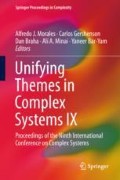Abstract
We propose a method for the non-parametric joint estimation of preferential attachment and transitivity in complex networks, as opposite to conventional methods that either estimate one mechanism in isolation or jointly estimate both assuming some functional forms. We apply our method to three scientific co-authorship networks between scholars in the complex network field, physicists in high-energy physics, and authors in the Strategic Management Journal. The non-parametric method revealed complex trends of preferential attachment and transitivity that would be unavailable under conventional parametric approaches. In all networks, having one common collaborator with another scientist increases at least five times the chance that one will collaborate with that scientist. Finally, by quantifying the contribution of each mechanism, we found that while transitivity dominates preferential attachment in the high-energy physics network, preferential attachment is the main driving force behind the evolutions of the remaining two networks.
Access this chapter
Tax calculation will be finalised at checkout
Purchases are for personal use only
References
Nowak, M.A.: Five rules for the evolution of cooperation. Science 314(5805), 1560–1563 (2006). http://science.sciencemag.org/content/314/5805/1560
Dugatkin, L.A.: Cooperation Among Animals: An Evolutionary Perspective. Oxford University Press, Oxford (1997)
Watson, A.: Diplomacy. Routledge, London (1984)
Hamel, G., Doz, Y.L., Prahalad, C.K.: Collaborate with your competitors-and win. Harv. Bus. Rev. 67(1), 133–139 (1989). https://hbr.org/1989/01/collaborate-with-your-competitors-and-win
Johnson, D.W., Johnson, R.T., Smith, K.A.: Active Learning: Cooperation in the College Classroom. Interaction Book Company, Edina (1991)
Larivière, V., Gingras, Y., Sugimoto, C.R., Tsou, A.: Team size matters: collaboration and scientific impact since 1900. J. Assoc. Inf. Sci. Technol. 66(7), 1323–1332. https://onlinelibrary.wiley.com/doi/abs/10.1002/asi.23266
Bornmann, L.: Is collaboration among scientists related to the citation impact of papers because their quality increases with collaboration? An analysis based on data from F1000Prime and normalized citation scores. J. Assoc. Inf. Sci. Technol. 68(4), 1036–1047 (2017). https://doi.org/10.1002/asi.23728
Tahai, A., Meyer, M.J.: A revealed preference study of management journals’ direct influences. Strateg. Manag. J. 20(3), 279–296 (1999). https://onlinelibrary.wiley.com/doi/abs/10.1002/%28SICI%291097-0266%28199903%2920%3A3%3C279%3A%3AAID-SMJ33%3E3.0.CO%3B2-2
Holme, P., Kim, B.J.: Growing scale-free networks with tunable clustering. Phys. Rev. E 65, 026107 (2002)
Newman, M.E.J.: Coauthorship networks and patterns of scientific collaboration. In: Proceedings of the National Academy of Sciences, vol. 101(suppl 1), pp. 5200–5205 (2004). http://www.pnas.org/content/101/suppl_1/5200
Newman, M.E.J.: Scientific collaboration networks. I. network construction and fundamental results. Phys. Rev. E 64, 016131 (2001). https://link.aps.org/doi/10.1103/PhysRevE.64.016131
Krapivsky, P., Rodgers, G., Redner, S.: Degree distributions of growing networks. Phys. Rev. Lett. 86(23), 5401–5404 (2001)
Pham, T., Sheridan, P., Shimodaira, H.: PAFit: a statistical method for measuring preferential attachment in temporal complex networks. PLoS ONE 10(9), e0137796 (2015)
Newman, M.: Clustering and preferential attachment in growing networks. Phys. Rev. E 64(2), 025102 (2001)
Jeong, H., Néda, Z., Barabási, A.: Measuring preferential attachment in evolving networks. Europhys. Lett. 61(61), 567–572 (2003)
Ripley, R., Boitmanis, K., Snijders, T.A.: RSiena: Siena - Simulation Investigation for Empirical Network Analysis, R package version 1.1-232 (2013). https://CRAN.R-project.org/package=RSiena
Krivitsky, P.N., Handcock, M.S.: tergm: Fit, Simulate and Diagnose Models for Network Evolution Based on Exponential-Family Random Graph Models. The Statnet Project. R package version 3.4.0 (2016). http://www.statnet.org, http://CRAN.R-project.org/package=tergm
Kong, J., Sarshar, N., Roychowdhury, V.: Experience versus talent shapes the structure of the web. Proc. Nat. Acad. Sci. U.S.A. 37, 105 (2008)
Hunter, D., Lange, K.: Quantile regression via an MM algorithm. J. Comput. Graph. Stat. 9, 60–77 (2000)
Pham, T., Sheridan, P., Shimodaira, H.: PAFit: an R Package for the Non-parametric Estimation of Preferential Attachment and Node Fitness in Temporal Complex Networks. ArXiv e-prints, April 2017
KONECT: arxiv hep-th network dataset. http://konect.uni-koblenz.de/networks/ca-cit-HepTh. Accessed 03 May 2018
Ronda-Pupo, G.A., Pham, T.: The evolutions of the rich get richer and the fit get richer phenomena in scholarly networks: the case of the strategic management journal. Scientometrics, May 2018. https://doi.org/10.1007/s11192-018-2761-3
Zimmermann, F.: High-energy physics strategies and futurelarge-scale projects. Nucl. Instr. Meth. Phys. Res. Sect. B: Beam Interact. Mater. Atoms 355, 4–10 (2015). http://www.sciencedirect.com/science/article/pii/S0168583X1500350X. Proceedings of the 6th International Conference Channeling 2014: Charged & Neutral Particles Channeling Phenomena, 5–10 October 2014, Capri, Italy
Birnholtz, J.P.: What does it mean to be an author? The intersection of credit, contribution, and collaboration in science. J. Am. Soc. Inf. Sci. Technol. 57(13), 1758–1770. https://onlinelibrary.wiley.com/doi/abs/10.1002/asi.20380
Pham, T., Sheridan, P., Shimodaira, H.: Joint estimation of preferential attachment and node fitness in growing complex networks. Sci. Rep. 6 (2016). https://doi.org/10.1038/srep32558
Author information
Authors and Affiliations
Corresponding author
Editor information
Editors and Affiliations
Rights and permissions
Copyright information
© 2018 Springer Nature Switzerland AG
About this paper
Cite this paper
Inoue, M., Pham, T., Shimodaira, H. (2018). Transitivity vs Preferential Attachment: Determining the Driving Force Behind the Evolution of Scientific Co-Authorship Networks. In: Morales, A., Gershenson, C., Braha, D., Minai, A., Bar-Yam, Y. (eds) Unifying Themes in Complex Systems IX. ICCS 2018. Springer Proceedings in Complexity. Springer, Cham. https://doi.org/10.1007/978-3-319-96661-8_28
Download citation
DOI: https://doi.org/10.1007/978-3-319-96661-8_28
Published:
Publisher Name: Springer, Cham
Print ISBN: 978-3-319-96660-1
Online ISBN: 978-3-319-96661-8
eBook Packages: Physics and AstronomyPhysics and Astronomy (R0)

